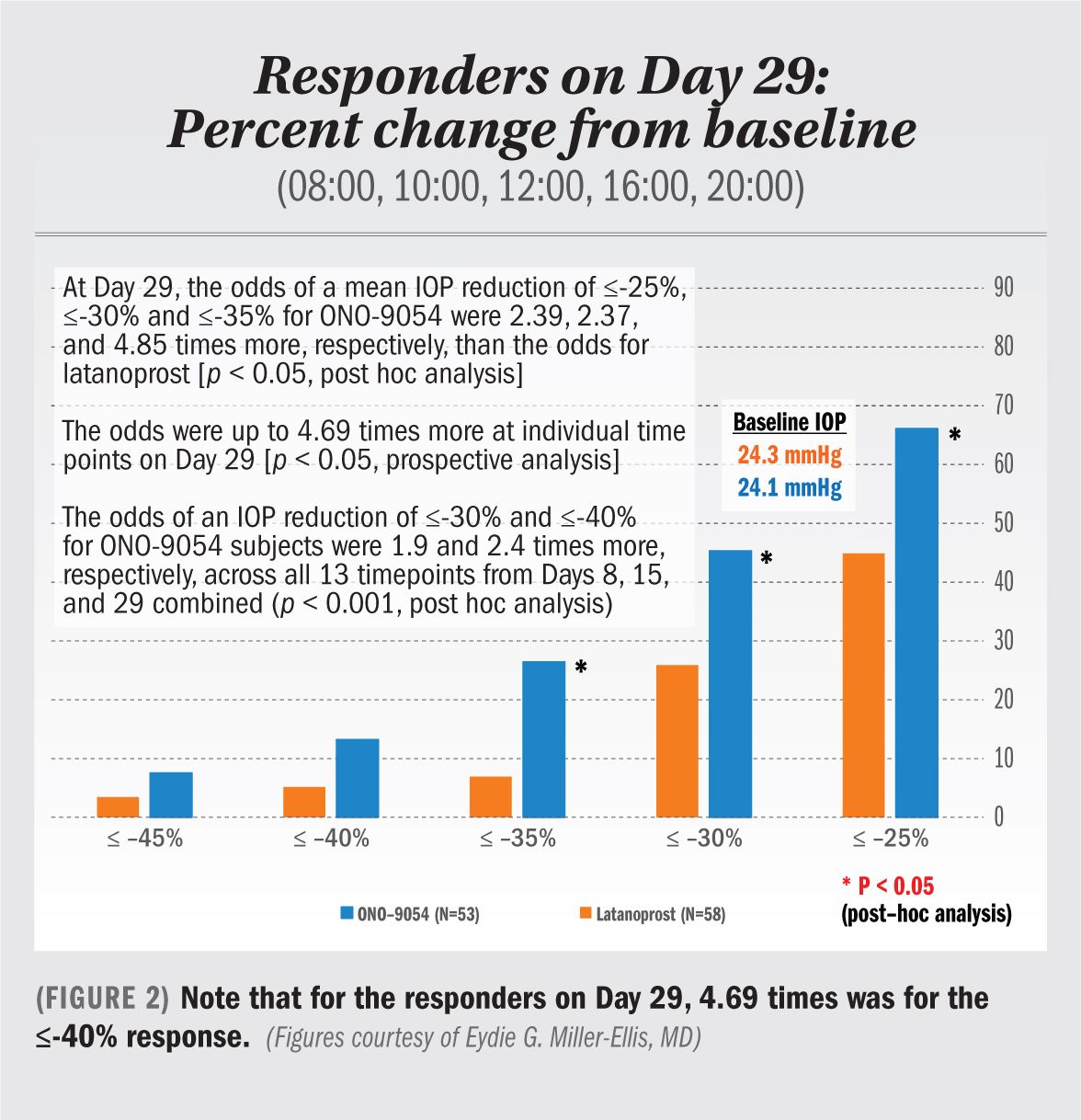Article
Novel dual agonist leads to notable IOP lowering
The drug ONO-9054 led to a greater reduction in IOP and a longer duration of reduction in a small clinical trial compared with latanoprost.
Take-home: The drug ONO-9054 led to a greater reduction in IOP and a longer duration of reduction in a small clinical trial compared with latanoprost.
Reviewed by Eydie G. Miller-Ellis, MD
Philadelphia-In a group of 123 patients, the drug ONO-9054 showed a greater reduction in IOP and a longer duration of IOP reduction compared with latanoprost (Xalatan, Pfizer), said Eydie G. Miller-Ellis, MD.
ONO-9054 is a highly selective and potent dual EP3 and FP prostanoid receptor agonist.
More: Cataract surgery may benefit these PAC/PACG patients
“It’s hypothesized that agonist activity against EP3 and FP receptors might provide more sustained reduction in IOP than the FP agonist latanoprost,” said Dr. Miller-Ellis, chief, glaucoma service, and professor of clinical ophthalmology, Perelman School of Medicine, University of Pennsylvania, Philadelphia.

Two previous clinical trials have shown that ONO-9054 both increases uveoscleral and trabecular outflow in animals and that it is safe and well tolerated in healthy normotensive adults and subjects with open-angle glaucoma (OAG) and ocular hypertension.
Related: What astronauts can teach us about glaucoma
The previous research has found IOP reductions both from single and repeated doses. The IOP reductions extended to 33 hours post-dose.
“There are clinically relevant reductions in IOP regardless of a.m. or p.m. dosing,” Dr. Miller-Ellis said.
Comparator study
Comparator study
In the latest research with ONO-9054, a double-masked, parallel group, active comparator study, ONO-9054 was compared against latanoprost using once-daily doses at 10 p.m. for 28 days. All subjects had either ocular hypertension or mild-to-moderate OAG.
Recent: Glaucoma gene therapy on positive trajectory using this technology
Investigators measured IOP at 8, 10, and 12 o’clock every day as well as 4 and 8 o’clock at 1 and 29 days. The primary comparison measure was change from baseline to day 29 in terms of mean IOP at all time points. The secondary measure was safety and tolerability, Dr. Miller-Ellis said.

Investigators found a similar baseline of 24 mm Hg in both treatment groups. Although both ONO-9054 and latanoprost had a significant IOP reduction compared with the untreated baseline, ONO-9054 patients had a more significant drop in IOP, Dr. Miller-Ellis said. This drop was particularly noticeable later in the day.
Related: Laser therapy addresses bilateral glaucoma in single treatment
“On day 29, the odds of a more than 25%, 30%, and 35% reduction in IOP were 2.39, 2.37, and 4.85 more with ONO-9054 than the odds for [latanoprost],” Dr. Miller-Ellis said.
There was also a greater change that ONO-9054 would reduce the IOP by 30% or 40%.
When investigators selected an IOP goal, such as 17 or 15 mm Hg, such at target was more likely to be reached by the subjects on ONO-9054.
Safety, tolerability
Safety and tolerability were similar between the two medications. The only adverse events were ocular in nature and mild or moderate in severity. One case of nonarteritic ischemic optic neuropathy, a serious adverse event, occurred, but it was not related to the study medications.
More: Pediatric glaucoma's impact beyond clinical effects
Both medications were associated with hyperemia, which occurred in 12 subjects using ONO-9054 and 5 subjects using latanoprost. The cases of hyperemia all resolved without incident.
Related: Rocket 2 announces safety results for netarsudil
Eydie G. Miller-Ellis, MD
E: eydie.miller-ellis@uphs.upenn.edu
This article was adapted from Dr. Miller-Ellis’ presentation at the 2015 meeting of the American Academy of Ophthalmology. Dr. Miller-Ellis is a consultant for ONO Pharmaceutical.
Newsletter
Don’t miss out—get Ophthalmology Times updates on the latest clinical advancements and expert interviews, straight to your inbox.




